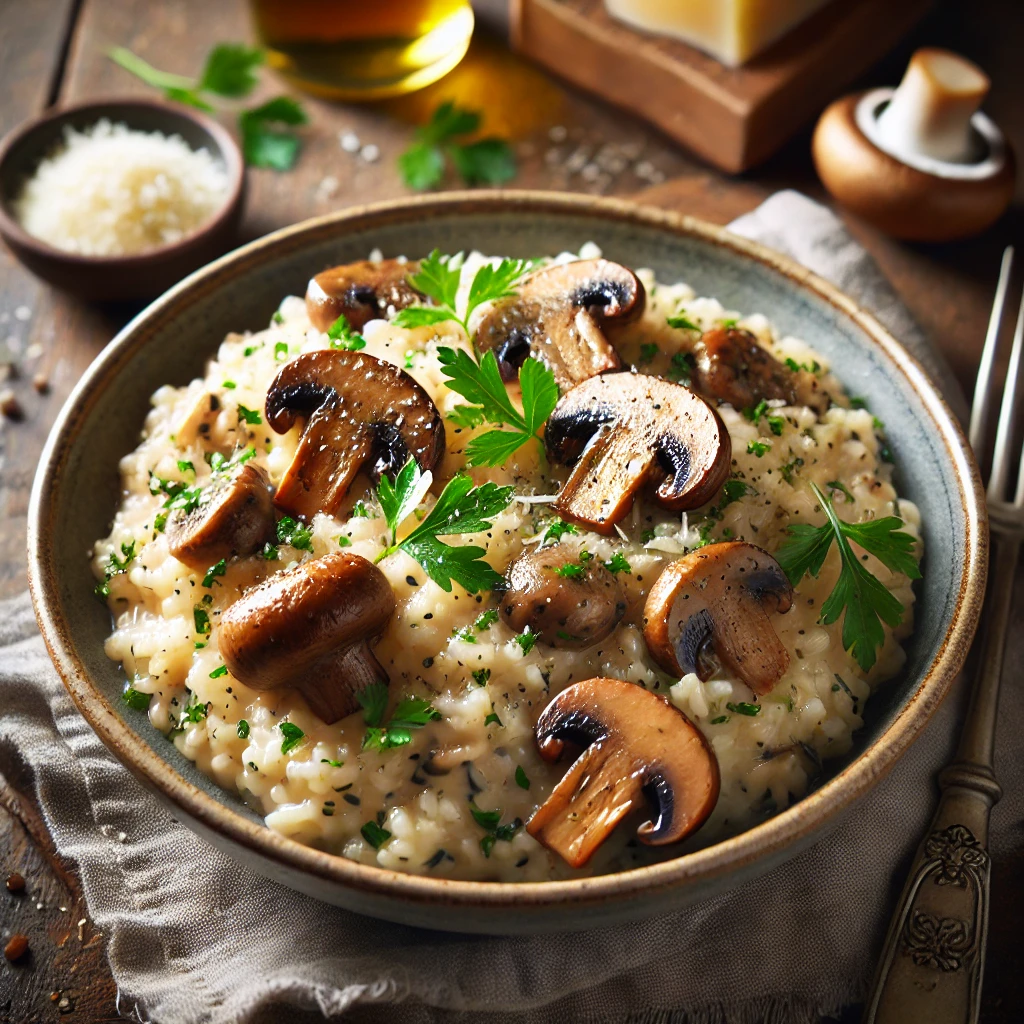Mushroom risotto is an Italian classic, renowned for its creamy texture, earthy flavors, and luxurious appeal. It’s the perfect dish for showcasing the versatility of mushrooms while maintaining a simple elegance that turns a humble meal into an exquisite dining experience. Whether you’re a seasoned home chef or just starting out in the kitchen, mushroom risotto offers the perfect blend of challenge and reward. In this blog post, we’ll dive deep into the world of mushroom risotto—its history, tips for perfect preparation, key ingredients, and a step-by-step recipe that guarantees a mouthwatering result.
The Origin of Risotto
Risotto, at its core, is a traditional Italian rice dish made by cooking short-grain rice, such as Arborio or Carnaroli, in broth until it reaches a creamy consistency. It’s believed to have originated in northern Italy, particularly in the Lombardy and Piedmont regions, where rice paddies have flourished since the Middle Ages. The dish is closely associated with the Italian culinary philosophy of “cucina povera,” or peasant cooking, which focuses on making the most of available ingredients.
While risotto was originally a staple food for the working class, over time, it evolved into a more refined dish, gaining prominence in high-end restaurants across the world. Its versatility is one of its greatest strengths: risotto can be served as a starter, a main course, or even as a side dish. While the classic saffron-flavored Risotto alla Milanese is iconic, mushroom risotto has gained a strong following thanks to its robust, earthy flavors and satisfying richness.
Why Mushrooms?
Mushrooms are a natural complement to risotto for several reasons. First, their texture, when cooked properly, is both meaty and tender, offering a satisfying bite. Second, mushrooms, particularly wild varieties like porcini, shiitake, or morels, are deeply umami-rich, which enhances the overall flavor of the risotto. Umami, often referred to as the “fifth taste,” adds depth and complexity to dishes, making mushroom risotto a flavor-packed experience.
Mushrooms are also widely available and incredibly versatile, ranging from common cremini or button mushrooms to exotic varieties like chanterelles and maitake. This wide range allows home cooks to experiment and elevate their risotto depending on the types of mushrooms they choose. Their earthy flavor also pairs exceptionally well with creamy, buttery risotto, making them a popular choice for this beloved dish.
Key Ingredients
The beauty of mushroom risotto lies in its simplicity, but achieving the perfect balance requires attention to each ingredient. Here are the key components that bring this dish together:
1. Rice
The foundation of any risotto is the rice, and not just any type will do. Arborio, Carnaroli, and Vialone Nano are the most common types of rice used in risotto because of their high starch content. This starch is crucial for creating the creamy texture that defines a good risotto.
- Arborio: The most commonly used risotto rice, known for its plump grains and ability to absorb liquids well. It produces a creamy, slightly firm risotto.
- Carnaroli: Often considered superior to Arborio, Carnaroli rice retains its shape better and provides a silkier texture. It’s favored by chefs for its ability to deliver a more consistent al dente bite.
- Vialone Nano: A bit more delicate than the other two, Vialone Nano is excellent for lighter risottos, especially when using vegetables or seafood.
2. Mushrooms
Mushrooms are the star of the show in this dish. You can use a variety of mushrooms depending on availability and personal preference:
- Cremini: Also known as baby bella mushrooms, they have a deeper flavor than white button mushrooms and are widely available.
- Porcini: With their intense, woodsy flavor, porcini mushrooms are highly prized and often used in risottos. Dried porcini can be rehydrated and used if fresh ones are not available.
- Shiitake: These mushrooms are known for their meaty texture and robust flavor, adding an extra dimension to the risotto.
- Chanterelle or Maitake: More exotic and flavorful, these mushrooms are perfect if you want to elevate the dish to a gourmet level.
- Portobello: These large mushrooms are excellent for their meaty texture, which holds up well in risotto.
3. Stock or Broth
The stock used in risotto plays a major role in flavor. Traditionally, a good homemade chicken or vegetable stock is preferred, but store-bought stocks can also work. The key is to ensure that the stock is warm when added to the rice, as cold stock can affect the cooking process and result in uneven texture. For mushroom risotto, you can also use a mushroom stock, made from soaking dried mushrooms or simmering fresh ones, for an even deeper mushroom flavor.
4. Wine
A splash of white wine, typically added after the rice is toasted, adds acidity and balance to the richness of the dish. While a dry white wine like Pinot Grigio, Sauvignon Blanc, or Chardonnay is commonly used, feel free to choose a wine you enjoy drinking.
5. Cheese
Parmigiano-Reggiano (Parmesan) is the traditional cheese added to risotto for its nutty flavor and creamy consistency. Grated parmesan melts into the dish, adding an extra layer of richness and binding the flavors together. Some variations also use Pecorino Romano, a saltier, sheep’s milk cheese.
6. Butter and Olive Oil
Butter adds richness to the risotto, particularly when stirred in at the end to finish the dish. Olive oil, used to sauté the mushrooms and onions, brings additional flavor and a healthier fat option.
7. Herbs
Herbs like thyme, parsley, and chives are commonly added to mushroom risotto for freshness and fragrance. Thyme pairs exceptionally well with mushrooms due to its slightly floral, woodsy aroma.
Tips for Perfect Mushroom Risotto
Making risotto is not difficult, but it does require patience and attention to detail. Here are some essential tips for making perfect mushroom risotto:
1. Toast the Rice
Before adding any liquid, toast the rice grains in the pan with olive oil or butter until they are slightly translucent. This step, called tostatura, helps the rice maintain its structure throughout the cooking process and enhances the flavor.
2. Warm the Stock
Always add warm stock to the rice, a little at a time. Adding cold stock can shock the rice and slow down the cooking process. The idea is to keep the rice at a steady, gentle simmer throughout.
3. Stir Constantly, But Not Too Much
You want to stir the rice frequently enough to help release the starch, which contributes to the creaminess of the risotto. However, too much stirring can break down the rice grains and turn the risotto gummy. Stir gently and consistently, but give the rice time to absorb the liquid between each addition of stock.
4. Cook Until Al Dente
Risotto should be cooked until the rice is tender but still has a slight bite (al dente). Overcooked risotto becomes mushy and loses its appealing texture.
5. Finish with Butter and Cheese
Stir in a generous amount of butter and parmesan at the very end to give the risotto a glossy, creamy finish. This final step, known as mantecatura, adds richness and ensures the risotto is smooth and luxurious.
Mushroom Risotto Recipe
Ingredients:
- 1 ½ cups Arborio rice
- 1 lb mixed mushrooms (cremini, shiitake, and porcini recommended), cleaned and sliced
- 1 small onion, finely chopped
- 4 cups chicken or vegetable stock, kept warm
- ½ cup dry white wine
- ½ cup grated Parmigiano-Reggiano cheese
- 2 tablespoons olive oil
- 2 tablespoons unsalted butter
- 2 cloves garlic, minced
- 2 teaspoons fresh thyme leaves
- Salt and pepper to taste
- Fresh parsley, chopped (for garnish)
Instructions:
- Prepare the mushrooms: Heat 1 tablespoon of olive oil in a large skillet over medium heat. Add the sliced mushrooms, garlic, and thyme, sautéing until the mushrooms are golden brown and tender (about 5-7 minutes). Season with salt and pepper. Set aside.
- Cook the risotto: In a large pot, heat the remaining olive oil and half of the butter over medium heat. Add the chopped onion and cook until softened (about 3 minutes). Add the Arborio rice and toast the grains, stirring frequently, until they become slightly translucent, about 2-3 minutes.
- Deglaze with wine: Pour in the white wine and stir until it has mostly evaporated. This step infuses the rice with a burst of acidity, enhancing the overall flavor.
- Add stock: Begin adding the warm stock one ladleful at a time, stirring frequently. Wait for each addition to be absorbed by the rice before adding the next ladle of stock. Continue this process until the rice is creamy and cooked al dente, about 18-20 minutes.
- Combine mushrooms and rice: Once the risotto is done, gently fold in the sautéed mushrooms, being careful not to overmix. Stir in the remaining butter and grated parmesan cheese to finish the risotto.
- Garnish and serve: Season with salt and pepper to taste. Garnish with fresh parsley and an additional sprinkle of parmesan if desired. Serve immediately.
Final Thoughts
Mushroom risotto is a delicious and comforting dish that showcases the earthy flavors of mushrooms with the rich, creamy texture of perfectly cooked risotto. With a few simple ingredients and some careful attention, you can create a dish that is both satisfying and elegant. Whether you’re making it for a special occasion or just a cozy night in, mushroom risotto is sure to impress and comfort in equal measure. Bon appétit!






